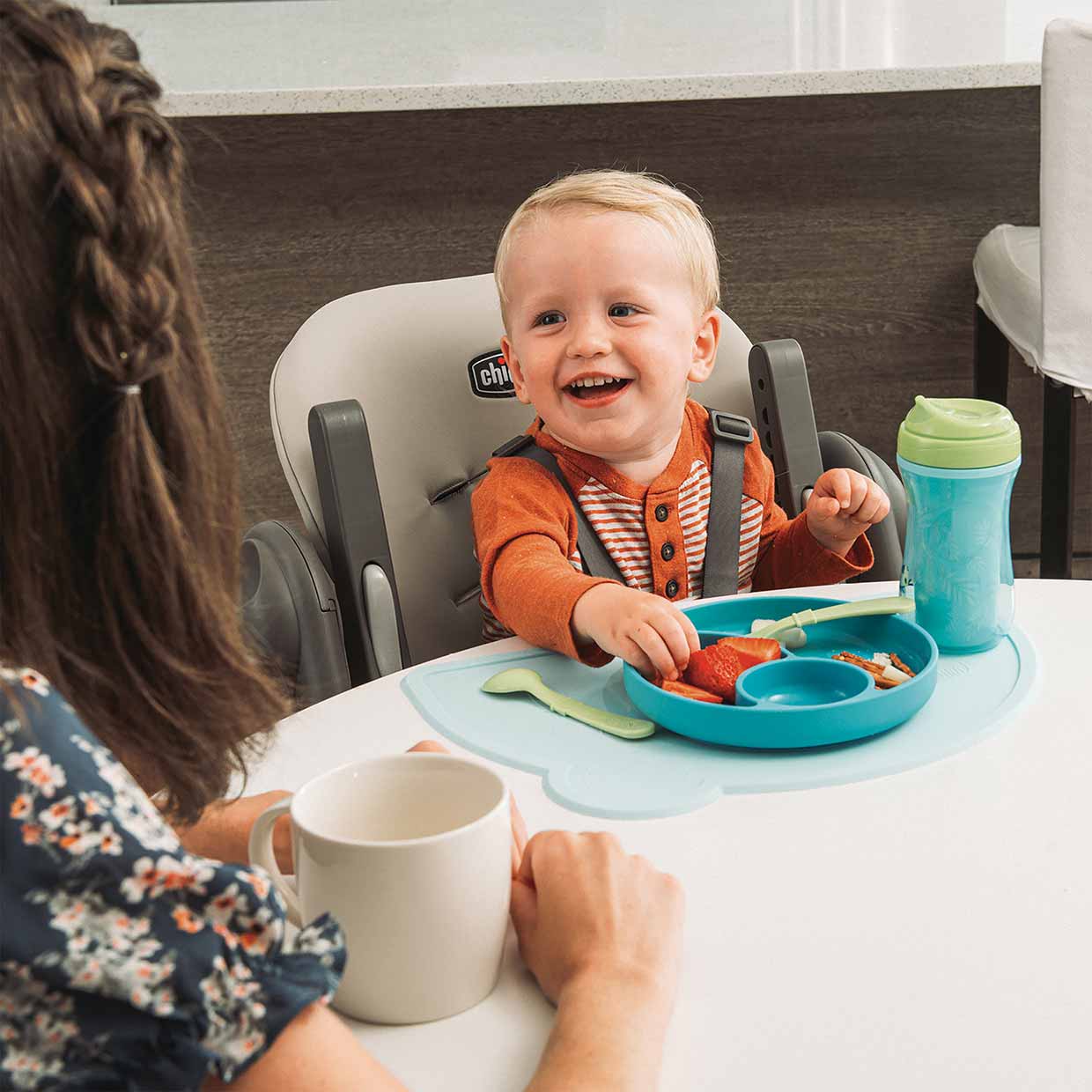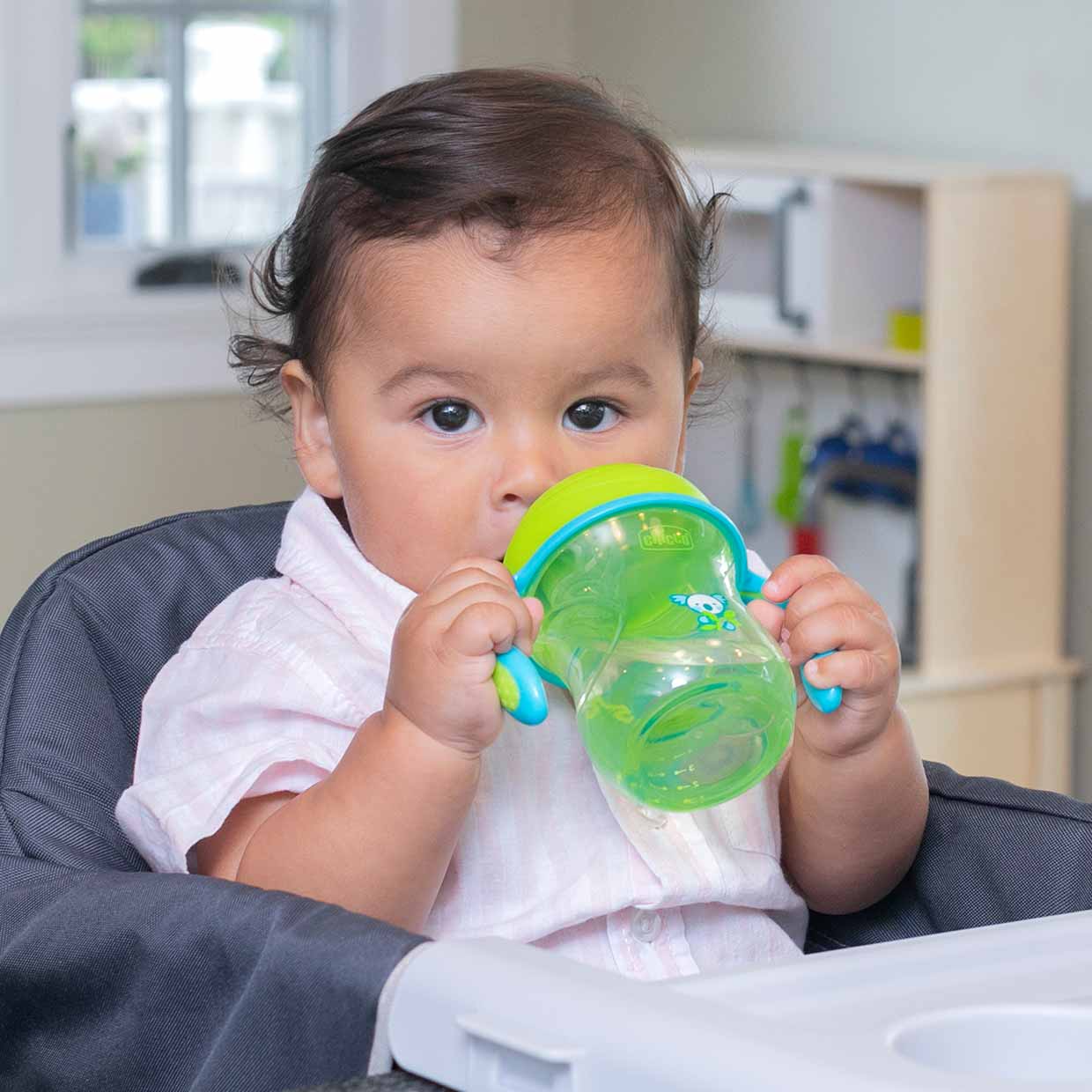
Feeding your baby solid food for the first time is a fun and unique bonding experience. You get to watch your little one squish their face after tasting a food they dislike or gobble up a piece of food they love! As you begin the process of introducing solid food to your baby, you’ll likely have many questions like what are the best foods to introduce and what are the signs your baby is ready to explore solids. We put together this helpful guide to cover the ins and outs of introducing solid foods to your little one so you can help them venture into a world of new textures and flavors with confidence!
Your little one is most likely ready to try solid foods at 6 months old. The CDC recommends not introducing solid food to your baby before 4 months old. You can always talk to your pediatrician if you feel your baby is ready to try solids before they’ve hit the 6-month benchmark. Every baby is different so what worked for your friend’s baby may not work for yours. Below, we’ll walk through some signs your little peanut is ready to venture into solids!
While your baby might be able to babble, they still can’t speak and express themselves fully. However, there are still some ways you can understand what they want. Check out some of the signs your baby is ready to try solid food, below.
- Your Baby No Longer Has a Tongue Thrust Reflex: A tongue thrust reflex is when your baby pushes food back out with their tongue. Your baby should be able to move food to the back of their mouth and swallow it, rather than pushing it back out.
- Head and Neck Control: Your baby should be able to hold their head up so they don’t compromise their airway.
- Sit in a High Chair: Your baby should be able to sit up unassisted in their high chair without falling forward.
- Your Baby Shows an Interest in Food: Your baby may see everyone eating food at the table and want to join in! They may reach for your food or open and close their mouth when you bring a spoonful of food close by.
- Your Baby Loves Putting Things in Their Mouth: From teething toys to their very own fist — your baby’s taste buds are in full swing and they may want a snack!
Introducing your little one to the wonderful world of solid foods is definitely more enjoyable than some of the tougher tasks of parenting, like putting together a crib! Thankfully, our step-by-step guide can help fill you in on what you need to know.
Step 1: Don’t Rush the Process
If you’re coming home from work exhausted on a Friday night, that’s probably not the best time to introduce solids. Instead, pick a good time that works for you and your baby’s schedule. Typically an hour or so after bottle-feeding or breastfeeding is best.
Make sure both you and your baby are in a happy, relaxed mood. After all, introducing them to solids should be a fun experience!
Step 2: Create New Habits
Your baby’s high chair, booster chair, or hook-on chair is the perfect place to start their journey into the world of solids and self-feeding. Set them in their high chair and allow them to touch and feel silicone spoons, sippy cups, bowls, and other items that won’t break, should they throw them on the ground. Always keep any knives or other sharp items out of reach.
Step 3: Practice Makes Perfect
Babies need routine and practice for everything from potty training to sleep training and introducing them to solid food is no different!
Get ready for the mess ahead by outfitting your baby with a bib. You can place a dollop of the food in front of them so they can touch it, taste it, squish it, and have fun exploring it. Using a spoon, you can offer a small amount of food on the tip of their tongue and see if they swallow it. If they do, you can gently do it again, this time placing the spoon a little further back in their mouth.
Don't worry if your baby makes a mess, spits it back out, or shows reluctance to eat at first. This is normal, and they will need time and repetition to get used to all the new textures and flavors.
Your baby may also gag the first time they eat food. This is completely normal, however, if your baby vomits or has diarrhea, you may want to give them more time for their digestive system to adjust.
Be sure to introduce one food at a time to see if there are any allergic reactions. After a few days, you can switch to a new one. Remember to always supervise your baby while they're eating.
Pro tip: Babies learn by seeing! Show them how to eat the food and have fun with it. This will encourage your baby to do the same.
Step 4: Finish Up Mealtime
Watch for signs that your baby is finished eating, such as a clenched mouth, turning their head away from the spoon, or pushing the food away. If your baby didn’t finish everything on their plate — don’t worry! The goal of introducing solid foods is not to get them to eat everything but to expose them to new tastes, textures, and sensations.
Introducing solid foods is a process, and just like learning how to walk or talk, it takes time and practice. Your baby won't be an expert in one day so be patient and persistent. As your baby grows and develops, their appetite and eating habits will change, so be flexible and adjust your approach accordingly.
Pro tip: Keep a log of what food you introduce to your baby and when. This way, if they develop a rash or have tummy troubles, you know which food to avoid.
Since your baby will be deriving most of their nutrients from bottle feeding or breastfeeding, they need less solid food than you think. You can start introducing solid food during one meal (breakfast, lunch, or dinner) each week and consistently build from there.
If your baby is 6 months, you can give them one to two meals a day on top of their regular bottle-feeding schedule. Each meal can be 2 to 4 tablespoons.
Once your baby is 7-12 months, you can advance to three meals with each portion roughly the size of your baby’s fist. Every baby is different so continue to watch for hunger cues. Your little one might have days where they're just not feeling solid foods and prefer to stick to nursing or bottle-feeding. This doesn't mean that they have regressed in their development, but rather that they are beginning to assert their independence and develop their own food preferences.

Take a look at the list below to find out which foods are safe and appropriate for your baby to enjoy.
4 to 6 Months
Introduce pureed veggies, fruits, and yogurts. You can start them on soft foods such as baby applesauce and mashed bananas. Be sure to slowly introduce water in a sippy cup at this age too.
6 to 8 Months
You can move on to soft finger foods like peas and sliced bananas. Experiment and see what your baby gravitates toward.
After other solid foods are tolerated, the AAP recommends introducing infant-safe forms of peanut to your baby’s diet as early as 6 months to prevent allergies from forming. You can always talk to your pediatrician if certain allergies run in your family before introducing allergenic foods.
9 to 12 Months
You'll discover that even at nine months old, your baby's primary source of nutrition is still formula or breastmilk. However, it's also a great time to introduce some easily chewable solids to complement their diet. Consider offering sliced strawberries and scrambled eggs, as they can serve as nutritious supplements to their meals.
As your baby gets older and they start getting their first teeth, you can try adding chopped, ground, or mashed food into their diet. Think of small pieces of chicken or turkey.
As you start to introduce solid food to your little one, there are certain categories of foods you should avoid.
- Foods With Thick Skin: Stay away from foods with thick skin, such as raw apples. These are hard to chew and swallow.
- Foods That Irritate Gums: Avoid anything that would be sharp on your baby’s gums like chips or popcorn.
- Food That Is Hard to Break Down: Large, chewy pieces of meat can be difficult to break down and swallow.
- Foods That Are Too Hard: Don’t introduce raw nuts to your little one. These can be choking hazards.
- Foods That Could Block the Airway: Pay attention to the size and shape of the food you’re serving. Your baby’s airway is small and can easily get blocked by food that’s too big. Avoid round shapes like cherries or grapes by slicing them into halves or quarters. Slice hot dogs up into small pieces.
Always be on the lookout for reactions to new foods you introduce in case of allergies or sensitivities. Follow your pediatrician's recommendations on when to introduce certain foods like cow's milk. Never spoon feed your baby honey to treat a cough or drizzle it over their food because it can cause botulism in infants under 12 months, which can be fatal. Watch out for honey as an ingredient in cough medicines.
From bottle feeding to trying scrambled eggs for the first time — your baby is on their way to exploring new tastes and flavors! Pretty soon, they’ll be at the family table, excited to try solid food or at the very least smear it across their face. Get the camera ready and visit the Baby Talk Blog for more parenting tips!
